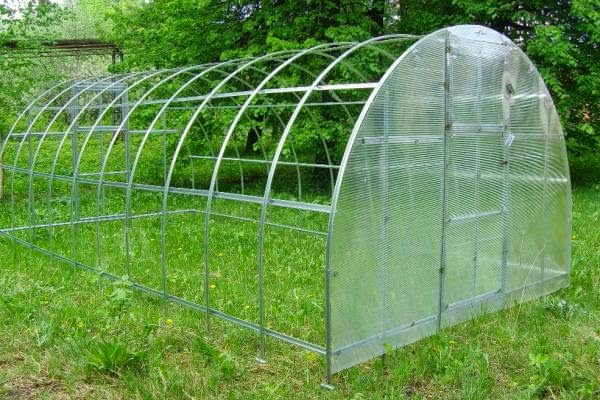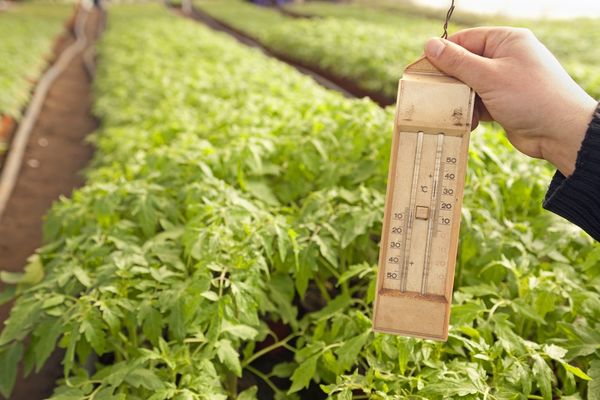Recommendations for growing tomatoes in a greenhouse: planting and care
Landing
A modern greenhouse can be built from ordinary plastic film, glass or the latest durable material - polycarbonate. In any case, it must be of normal size for good growth and harmonious development of the tomatoes. Growing a vegetable such as a tomato requires a competent approach, so it is important to provide for all the nuances.  After you build your greenhouse from polycarbonate or other material with all the necessary - comfortable lighting, a good ventilation system, that is, carry out all the preliminary preparations for planting a tomato, you can proceed to the next stage.It is necessary to prepare the soil inside the greenhouse for the subsequent planting of tomatoes.
After you build your greenhouse from polycarbonate or other material with all the necessary - comfortable lighting, a good ventilation system, that is, carry out all the preliminary preparations for planting a tomato, you can proceed to the next stage.It is necessary to prepare the soil inside the greenhouse for the subsequent planting of tomatoes.
Experts do not recommend growing tomatoes in the same greenhouse for several years in a row. In this case, cultures can often get sick.
Once upon a time, it was customary to plant tomatoes after cucumbers. But in recent years, these cultures began to get sick together with this method of planting - they are struck by an unpleasant ailment called anthracnose. That is why preparing for planting a tomato involves replacing the soil and processing it using a hot solution of copper sulfate - its temperature should be about 100 degrees. To prepare the solution yourself, you should take a tablespoon of this fertilizer.
Many novice summer residents often ask one question - is it possible to plant other vegetables together with tomatoes in the same polycarbonate or glass greenhouse? Experts say that other plants from the nightshade group get along well with them - for example, pepper. Therefore, planting tomatoes at the same time as pepper is perfectly acceptable. Since both of these crops - both peppers and tomatoes - require similar care conditions. Of course, planting peppers in the same room with tomatoes is best only when you can't do without it. In this case, the planting of pepper can be carried out both on a separate bed, and between the tomatoes.
The soil for peppers, like for tomatoes, should be loose and moist. There is even a special kind of pepper, which has an interesting shape and fruit color, which is called "tomato-like". It is also quite acceptable to plant tomatoes with eggplants. How to do this according to all the rules, the video at the end of the recording will tell you.
When there is a week left before planting tomatoes in the greenhouse, you need to carry out the stage of preparing the beds. Their width should be about 60 - 90 cm, and the height should be about 25 - 30 cm. Between the beds, you should definitely leave passages about 70 cm wide.For planting a tomato, it is customary to use clay or loamy soil after sawdust is added to it , humus and peat in equal proportions. For one square meter of land, you will need about three buckets of such a mixture. 
In the case when peat is used instead of soil, humus, turf, sawdust and sand must be mixed with it in a ratio of 1: 1: 1: 0.5.After preparing the soil, it should be fertilized with double granular superphosphate - you need to take a teaspoon of the product, as well as wood ash - it will take a couple of tablespoons. The preparation of planting material for planting in a polycarbonate, glass or film greenhouse invariably begins with growing seedlings. It is best to sow seeds in special containers from February to the end of March. After about 50 days, when the shoot is about 30 cm long, the tomato seedlings can be removed from the containers.
The planting scheme largely depends on the type of plant and the characteristics of its bushes. For example, in low-growing varieties with an early ripening period in a greenhouse, three shoots are formed, so they are advised to plant them in two rows, observing a checkerboard pattern, as shown in the video. In this case, two bushes should be at a distance of about 35 cm from each other. As for the standard varieties, in which one shoot is well developed, it is permissible to plant them more densely. But at the same time, the distance between crops should not be less than 30 cm. Since tall varieties of tomatoes need more space, it will be correct to plant them at a distance of about 70 cm from each other.
In this case, two bushes should be at a distance of about 35 cm from each other. As for the standard varieties, in which one shoot is well developed, it is permissible to plant them more densely. But at the same time, the distance between crops should not be less than 30 cm. Since tall varieties of tomatoes need more space, it will be correct to plant them at a distance of about 70 cm from each other.
Before planting plants in the ground, you should make sure that it has warmed up to a temperature of 15 degrees. It should also be remembered that the stems of the seedlings should not be too submerged in the soil, since in this case the tomato can go into the roots, and not into growth. The soil should not contain excessive amounts of nitrogen, as in this situation the foliage will grow excessively, not the fruit. After you have examined the seedling for damage, you can plant the future tomato in the ground. How to do it correctly, our video will demonstrate.
Hybrid varieties are best suited for greenhouse cultivation. They should be planted in warm ground in the first half of May, when the height of the seedling stems already reaches 30 - 35 cm. It is believed that after this age, the seedlings take root well in a new place and adapt to the proposed conditions. As mentioned above, tall varieties are planted in a checkerboard pattern, but medium and dwarf varieties require a different planting method - in rows, while the distance between plants should be about 40 cm.  Non-overgrown seedlings are planted vertically, if the plants are elongated, they must be placed in the prepared pits obliquely, tearing off the bottom sheets and sprinkling with earth. Pay extra attention to those seedlings that have outgrown. For her, a 12-centimeter hole should be made in the ground, in which another deeper hole is made, which coincides in height with the height of the pot in which the seedling is located. After a few weeks, the originally formed hole must be covered with earth.
Non-overgrown seedlings are planted vertically, if the plants are elongated, they must be placed in the prepared pits obliquely, tearing off the bottom sheets and sprinkling with earth. Pay extra attention to those seedlings that have outgrown. For her, a 12-centimeter hole should be made in the ground, in which another deeper hole is made, which coincides in height with the height of the pot in which the seedling is located. After a few weeks, the originally formed hole must be covered with earth.
Care
After about two weeks have passed since planting vegetable crops, they will need to be fertilized for the first time. Such feeding should consist of mullein and nitrophoska - at the rate of a tablespoon of nitrophoska, half a liter of liquid mullein per 10 liters of water.  Each bush should be watered with this solution, using a liter for each of them. After 10 days, it is necessary to feed the crops again using potassium sulfate and a fertilizer called "Fertility". To prepare such a fertilizer, add a tablespoon of the product and a teaspoon of potassium sulfate to 10 liters of water. It is recommended to use this top dressing about three times a season. You can see the steps for caring for tomatoes in the greenhouse in our video.
Each bush should be watered with this solution, using a liter for each of them. After 10 days, it is necessary to feed the crops again using potassium sulfate and a fertilizer called "Fertility". To prepare such a fertilizer, add a tablespoon of the product and a teaspoon of potassium sulfate to 10 liters of water. It is recommended to use this top dressing about three times a season. You can see the steps for caring for tomatoes in the greenhouse in our video.
Along with feeding the plants, caring for them also implies that crops should be watered in a timely manner and in the right amount. Remember not to water the tomatoes too much, as this can negatively affect the quality and taste of the fruit. Experts advise watering tomatoes every five days. Consider the fact that in the first ten days after planting, watering is also not desirable, since the crops have not yet had time to adapt to the new living conditions. When you take care of plants in a greenhouse, remember that the water temperature for irrigation should be around 20-22 degrees. 
The approximate amount of water that plants need before the flowering period is 4 - 5 liters per square meter. During the flowering period, this amount increases to 10 - 13 liters. It is best to water your crops in the greenhouse in the morning. Proper care of vegetable crops also involves maintaining an optimal temperature regime inside the greenhouse. When the weather is sunny outside, the temperature in the greenhouse should be about 20 - 22 degrees, with cloudy - 19 - 20. It is especially important to prevent sudden temperature fluctuations at night. The temperature during this period should be about 16 - 17 degrees before flowering.
After the crops bloom, the temperature should be 26 - 32 degrees. The lower limit of temperature during the flowering period is at least 14 - 16 degrees. After you have collected the first fruits, you can maintain the temperature in the greenhouse at 16-17 degrees. This can have a beneficial effect on the growth and ripening of tomatoes. Another important point of care is rightfully considered the pruning of stepchildren - lateral unnecessary processes developing on the leaves. They should be removed regularly, and the bush itself must be formed from the main shoot, on which about five brushes are left.
About a month before the end of the growing season, you need to pinch the top. When the fruits ripen and begin to turn red, the lower leaves are removed. Pruning is best done in the morning. In the process of caring for tomatoes, do not forget about the prevention of various diseases. Black leg disease is very dangerous for seedlings. To avoid the appearance of this fungus, the soil is changed to a new one before planting crops in the greenhouse. 
In order to prevent the development of late blight of leaves, the bushes are treated three times - a week after planting the seedlings, 20 days after the first treatment, and then after about a third of the brushes have bloomed. It is customary to process the bushes by means of "Barrier" and "Zaslon". The third treatment is recommended with a garlic solution.
Video "Growing tomatoes in greenhouse conditions"
A video on how to create optimal conditions for growing tomatoes, how to cope with diseases and how to form a bush.
